What to Look for in Cheap Solar Batteries
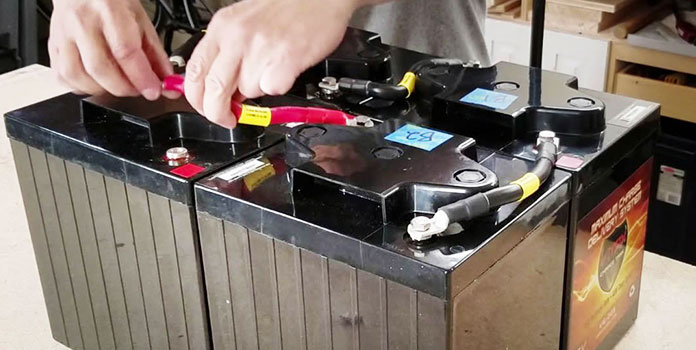
Low prices aren’t all you need to consider when adding batteries to your solar array.
If you’re looking for cheap solar batteries, then you’re probably leaning toward a good ol’ golf cart battery. They fulfill all your basic needs: they’re low-cost, reliable, and provide you with the power you need. However, a low sticker price isn’t everything you need to consider.
You also need to look at the longevity of the battery – how many usage cycles it can withstand before dying – to really see if it’s worth it. If a $100 battery only lasts for 300 cycles of use, is that really better than a $200 battery that lasts 1200 cycles? Absolutely not!
Let’s take a look at a few cheap solar batteries – both in initial sticker price as well as lifetime costs – and the factors that affect the cost-effectiveness of a battery.
The best cheap solar batteries
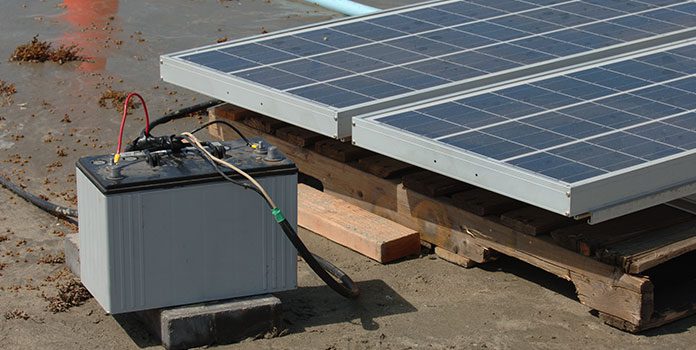
As we discuss cheap solar batteries today, we’ll be looking at two different kinds: flooded lead-acid batteries and lithium batteries.
Like we mentioned above, if you’re looking for a low-cost option, you’ll likely end up going with a golf cart-sized, flooded lead-acid battery. These require little upfront cash and are reliable and durable, though they do require maintenance and don’t last quite as long as batteries designed for renewable energy applications or lithium batteries.
It might seem counter-intuitive to include the ultra-expensive lithium battery in an article on cheap batteries, but hear us out: while they do in fact cost more upfront (okay much, much more actually), they last so long you’ll actually end up spending about the same amount over the lifespan of the batteries.
Also, an important note – because we’re limiting ourselves to what’s cheap, we’re going to skip lead-acid AGM (also known as sealed lead-acid batteries). They’re more expensive than flooded lead-acid batteries and come with some serious perks (you can lay them on their sides, for example), but they don’t really last any longer than flooded batteries, so they’re cost-effectiveness remains the same. If you’d like to know more about them, read our post Is an AGM Battery Right For You?
Important factors when looking at battery cost
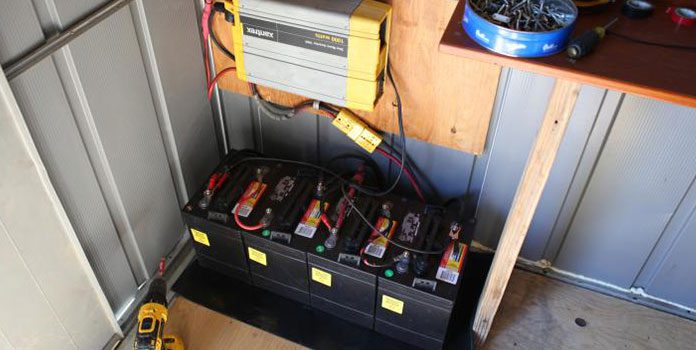
When you’re assessing battery cost, there are four main factors to be aware of:
- Initial Purchase Price – Obviously, the higher the price, the more you have to pay out of pocket.
- Battery Capacity and Voltage – For deep-cycle batteries used for energy storage, this is measured in amp-hours (Ah) and can range from 35Ah to over 1000Ah or more. If you’re looking to buy batteries for your solar installation, we’ll assume you already know what size battery backup you’ll need. If you don’t, take a look at our article How to Make a DIY Battery Bank for Your Solar Panels for a step-by-step guide. Voltage also plays a crucial role in your batteries’ total electricity production. Most small solar installations are 12 volts, though that increases to 24 or 48 volts for large-scale projects. Golf-cart batteries are 6 volt, so you’ll need two of them to make a 12 volt system.
- Recommended Depth of Discharge (DoD) – For lead-acid batteries, most manufacturers recommend discharging only to about 50% of the battery’s total capacity. So if your electricity needs come out to 500 amp-hours, you’ll need 1000 amp-hours of battery capacity. Lithium batteries can handle up to an incredibly high 80%, but you’re going to pay for that bonus!
- Cycle Life – A battery’s spec sheet should detail the relationship between the DoD and cycle life. This is the total amount of times you can discharge and recharge your battery – known as a cycle. The deeper you discharge your battery, the fewer cycles it can handle. A good quality lead-acid battery, like the Trojan Signature Series, can handle around 1200+ cycles at 50% discharge. With the same battery, if you increase DoD to 70% (using 70% of the battery’s capacity), your total number of cycles drops to 750. Only using 30% of your battery jumps the cycles up to over 2,000!
How do you take all of this data into account when you’re looking for cheap solar batteries? It’s actually really easy! You just need to find the $ per lifetime amp-hour cost for all the electricity the battery will ever produce. Let’s run through an example:
You just installed a solar panel on your RV and purchased a 100 amp-hour,12 volt battery for $180. It’s a standard flooded lead-acid battery that, just like the Trojan battery above, can spit out 1200 cycles with a regular 50% DoD.
At this rate, your battery will provide 60,000 amp-hours over its entire lifetime.
Now, all we need to do is find the $/Ah cost. We paid $180 for the battery, so
With this calculation, we can compare battery costs across different technologies, capacities, DoD, and cycle life. Pretty cool, right? Now that we know how to find the total cost of a solar battery over its entire lifespan, let’s took a look at the best cheap solar batteries out there.
Golf cart batteries: as cheap as you can get
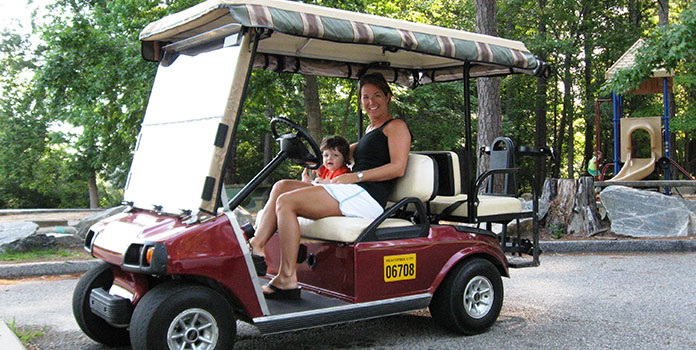
For most of us looking to spend as little as possible on our solar backup, golf cart batteries work great for our needs. Every golf cart in the world uses them, so they’re plentiful and relatively cheap. These batteries are designed to handle deep, daily discharging without many issues.
Seeing how they can withstand all this use/abuse, many DIYers use golf cart batteries in their solar and other renewable projects. As we’ve mentioned though, with their low price also comes a shorter lifespan: typically around 5 to 6 years. That doesn’t mean they’re not cost-effective though! Take a look at the stats for the Crown batteries below – manufacturer of some great golf cart batteries for energy storage.
Crown Batteries
- Lifetime cost: $0.17/100Ah
- Initial Cost (as of May 2018): $115 ($115 x 2 = $230 for 12 volt system)
- Capacity/Voltage: 220 Ah, 6v
- DoD/Cycles: 1200 cycles @ 50% DoD
Crown’s line of golf-cart batteries are about as good as you can get if you’re looking on the lower end of solar storage. At just $0.17 per 100Ah of power, they’re super cheap and see an excellent number of cycles at 50% DoD. You’d be hard-pressed to find a better deal for a well-regarded battery!
Dedicated solar batteries: slightly more expensive, longer lasting
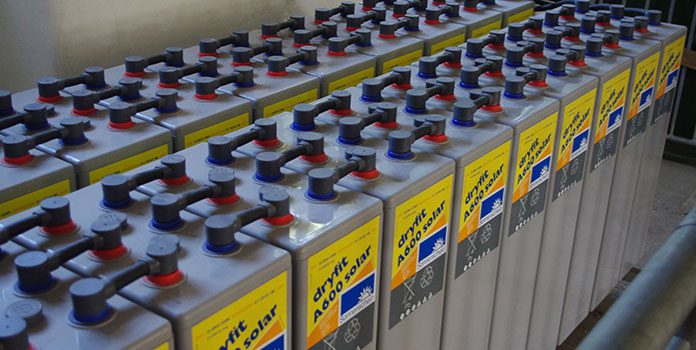
With the advance of renewable energy and storage systems, more and more manufacturers are developing long-lasting, durable, deep-cycle batteries specifically designed for solar and other renewable systems. These batteries can range in type (flooded, AGM lead-acid and lithium), capacity, and physical size (golf cart sizes up to industrial sizes).
Sticker prices fluctuate from as little as $150 well up into the thousands, depending on the capacity, brand, and technology. If you’re on a budget and looking for a battery designed specifically for solar, flooded lead-acid batteries (like in golf carts) are still going to be your best bet, and there are some great budget-conscious options out there for solar applications.
While it seems that Trojan is no longer manufacturing their popular T-105RE battery, as of April 2018 you can still find it for sale online for around $170. Based on their popular golf cart battery the T-105, the RE was specifically designed for renewable energy applications with beefier interior components able to withstand 8 or so years of use. Compare that to the 5 to 6 years of the typical golf cart battery, and you’ll understand why it was such a hit.
Trojan T-105RE
- Lifetime cost: $0.18/100Ah
- Initial Cost (as of April 2018): $170 ($170 x 2 = $340 for 12 volt system)
- Capacity/Voltage: 225 Ah, 6v
- DoD/Cycles: 1700 cycles @ 50% DoD
You can see that even though the Trojan batteries are about 30% more expensive than the Crown batteries above, thanks to their high number of cycles – and resulting longer life – their lifetime cost ($0.18/100Ah) is just a hair above the Crown batteries. Just a penny more for a battery designed to specifically handle the rough and tumble life of solar storage? Seems like a good deal. Trojan manufactures batteries that are the perfect meeting point between cost and longevity.
Lithium batteries: not cheap, but cost effective
Lithium batteries can also fall into the ‘dedicated solar batteries’ category above, but we’re separating them out into their own section since they’re so different than the lead-acid options we looked at above.
Lithium batteries have quite a few advantages over lead-acid batteries: shorter charge time, longer cycle life (3,000 to 10,000 cycles), deeper DoD (typically around 80%), and no maintenance.
However, with these benefits, you’re also be paying around 10x more than a lead-acid battery. Is it worth it? Well, if your definition of ‘cheap’ is a low initial investment, absolutely not. But, if your definition of ‘cheap’ is ‘cost-effective’, then they might just make sense for you.
Case in point, consider the SimpliPhi LiFePo (lithium-iron-phosphate) 102Ah battery.
SimpliPhi LiFePo 102Ah
- Lifetime cost: $0.21/100Ah
- Initial Cost: $1,675
- Capacity/Voltage: 102Ah, 12v
- DoD/Cyles: 10,000 cycles @ 80% DoD
While the 102Ah battery costs an initial $1,675 (yikes!), this thing can be discharged down to 80% and still last 10,000 cycles, allowing you much, much more time to recoup that high investment. In fact, you’ll end up spending just $0.21/100Ah, just a smidge more than the flooded lead-acid batteries above, but with many more benefits. You’re suddenly considering lithium batteries for your solar backup, aren’t you?
Can’t I just use a car battery?
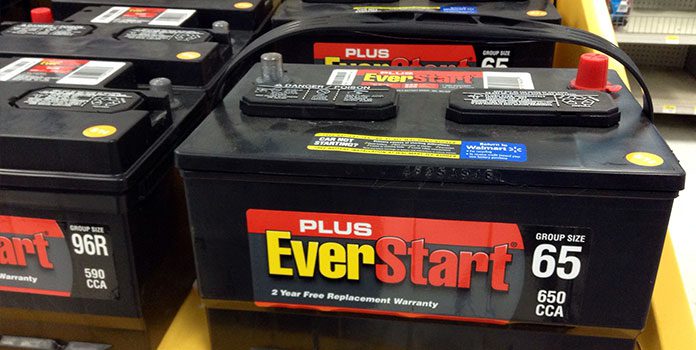
For those of us who are really looking to save some cash, you might be wondering, ‘Can’t I just use a car battery for my solar storage? They’re all batteries, right?’
While that is true, there’s a big difference between a car’s starter battery and the deep-cycle batteries designed for golf carts and energy storage.
All lead-acid batteries have lead plates submerged in an acidic mixture (65% water, 35% sulfuric acid). A chemical reaction between these two components creates electricity. The greater the surface area of the lead plates, the more instantaneous electricity can be created, but the more fragile the battery is.
When you’re starting your car to go to work in the morning, it needs a huge burst of electricity to get the motor going, but only for a fraction of a second. Starter batteries are designed to provide this by incorporating ‘spongy’ lead plates that increase the surface area, producing huge amounts of power. However, they can only handle a discharge of 3% or so. Any more than that, and the fragile lead plates begin to disintegrate.
Deep-cycle batteries like we’ve discussed above, though, have thick lead plates that can hold up to continual deep discharge, allowing you to use them over and over again.
So while a starter battery could, in fact, store your solar system’s electricity, it would quickly degrade and become unusable. Best to focus on deep-cycle batteries.
Buy used for the ultimate cheap solar battery
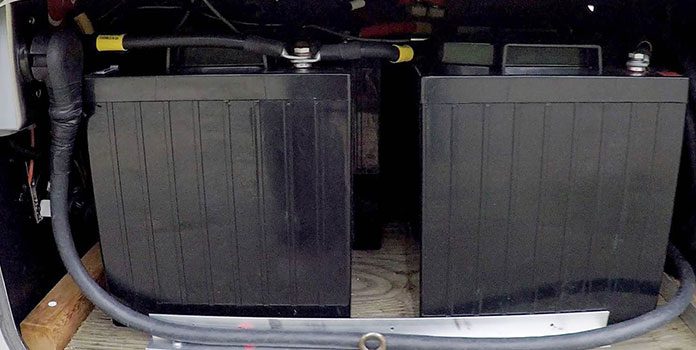
If you’re looking for the ultimate cheap solar battery, our best advice to you is buy used. You’ll need to replace it sooner than if you bought new, but if you choose wisely, you can get a great battery at an excellent price point.
A quick anecdote to illustrate the point: I (the author) just finished building out my own small solar installation for my camper. I have a single 100 watt solar panel connected to a 100Ah sealed AGM Deka battery. Deka’s latest 100Ah AGM batteries go for around $230, so when I found this battery for $50 at a used battery store, I was pretty ecstatic.
The store had recently purchased dozens of these batteries from a local hospital, who used them for emergency back-up power. Since they were from a hospital, they’d been in a perfect situation: rarely (if ever) used, constantly topped up with power, and in a climate-controlled room. And, as they’re for life-saving devices, the hospital had a policy to replace all their batteries every 4 years or so.
$50 for an AGM battery from a great company that still has years of use left? Yes please!
You can find used deep-cycle batteries anywhere: Craigslist (that’s how I found mine), Google Maps (just type in batteries and give the places a call), friends with boats or golf carts, etc. Just get creative and you’ll find something!
Of course, you need to know the batteries were well taken care of, otherwise the whole endeavor can end up being more hassle than its worth. I hit the jackpot with my battery, so maybe you will too!
No matter what batteries you purchase – new or used, lead-acid or lithium, golf cart or solar-specific – just work out the $/Ah cost to know whether it’s a good deal. You might be thinking you’re getting a once-in-a-lifetime deal on a cheap golf cart battery, but when you look at its cycle life and calculate the $/Ah cost, you realize you’ll actually spend more in the long run than if you spent a few more bucks on something a little nicer. Take your time, do your homework, and have fun building out your own renewable energy system!
If you’ve built your own solar backup system, tell us about your setup in the comments below!
Inspired to get a solar installation going on your own home? Reach out to a few installers to see what they can do for you.
